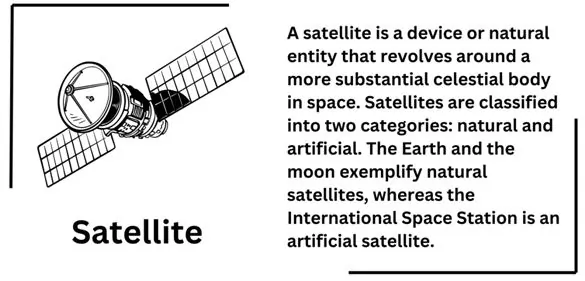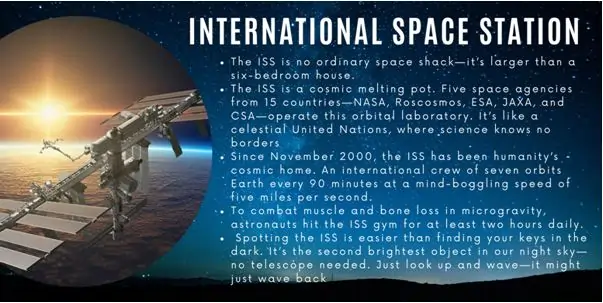A satellite is a device or natural entity that revolves around
a more substantial celestial body in space. Satellites are classified
into two categories: natural and artificial. The Earth and the moon
exemplify natural satellites, whereas the International Space Station
is an artificial satellite.

Types of Satellites: There are various types of satellites,those are mentioned below
Natural Satellites
- The Moon: Our dear moon which is revolving around our planet. It controls tidal activities, makes poets write and has seen most human activities before.
- Phobos and Deimos: Martian small companions of Mars which are irregular formations.
Artificial Satellites
These are deliberately placed by the human beings and these are the one we usually refer to as the artificial celestial objects. They come in different varieties based on their orbits:
a. Low Earth Orbit satellites
- Altitude: About 100–1000 Statute miles above the surface of the Earth.
- Characteristics: Short revolutions which takes approximately 90 minutes to complete.Perfect for communication, scientific experiments, and other applications with Earth observation needs.
- Examples: ISS (International Space Station): A live environment to experiment chamber which can be inhabited by astronauts.Meteors such as the Landsat and Sentinel-2 series are designed as an Earth-observing platform that records images of various resolutions of our planet.
b. Medium Earth Orbit (MEO) satellites
- Altitude: Around 8,000–20,000 kilometres.
- Characteristics: These require longer orbital periods which may take a few hours longer. Mainly used in navigation and Global positioning system.
- Examples: GPS (Global Positioning System) satellites: It assists us to get to the desired destination with an incredible level of accuracy.
c. Geostationary Orbit (GEO) Satellites
- Altitude: Approximately 35,786 kilometres’.
- Characteristics: As orbits are synchronous with Earth rotation they are scarcely visible from the ground.Ideal for TV broadcasting, weather monitoring and as a means of communication.
- Examples: Others, such as the GOES weather satellite systems monitor storms and climate change.As illustrated with Intelsat, communication satellites amplify television signals across several continents.
d. Sun-Synchronous Orbit or SSO Satellites
- Altitude: This depends with the distance covered but they can cover in the range of 600 and 800 kilometres.
- Characteristics: By the same local solar time cross the equator in consecutive orbits.Utilised for remote sensing and specifically for the observation of the earth and environment.
- Examples: Landsat 8: It is used for agriculture, Forest and for disaster management as it provides detailed images.Sentinel-3: tracks oceans, ice and land.
e. Geostationary Transfer Orbit or GTO Satellites
- Altitude: Starting in eccentric orbital configuration, these have to be raised to GEO orbit once in the geosynchronous orbit.
- Characteristics: Initial launch, to increase reliability and attain GEO.Accounting for enhanced reliability and communication effectiveness for communication satellites.
- Examples: As for now, Ariane 5 uses GTO in order to launch communication satellites into space.However, after some time Inmarsat satellites stabilise at GEO orbits while Eutelsat satellites also stabilise in GEO orbits.
What role satellite has in the future?
Quantum Communication Technology
A world in which distance is not a factor – forget the delays while waiting for signals to reach faraway places! Quantum communication offers just that in its ability to offer faster than light communication.This will pave way for more secured data transmission through satellites endowed with efficiencies in quantum communications; an essential upgrade for governments, and the financial industry, among other data sensitive entities. Picture this,a satellite sends a quantum signal encrypted to the earth and even the smartest hackers cannot decipher it.
Megacities and Urban Connectivity
With increase in population and urbanization thus the formation of various big cities and even megacities, satellites are poised to keep the cities connected.Satellite communication will be used in smart cities for transportation control and management, monitoring weather or climate conditions, disaster control among others.Therefore, another time when you will speak of traffic jams on the highway, do not forget that satellites play a role of traffic control of the jams.
Artificial Intelligence (AI) in Space
And while the more advanced artificial intelligence is still confined to the Earth in the form of, for instance, virtual assistants, buyers should start getting ready for interstellar AI shopping. Satellites will assimilate great amounts of data and apply AI algorithms to predict space weather conditions while adjusting satellite’s operations.Think of it as satellite self-improvement.
Miniaturization and CubeSats
The CubeSats? The CubeSats are smaller, lighter and more manoeuvrable than most of the conventional satellites.These pint-sized satellites are cheaper and can easily be produced in short span of time. It’s almost as if they are the shots of espresso for the space technologies.CubeSats are poised to lower the bar of space access, which means that anyone from universities, to start-ups and even do-it-yourself enthusiasts may launch their own space probes.
Environmental Monitoring
Satellites handing out a good check-up to our home known as planet earth, they will be able to check deforestation, measuring of greenhouse gases, quantify of soil moisture, and monitoring of the melting of polar ice caps.It’s like having a global Fit bit for the planet: “Earth, your, steps today that encircle the sun look good.”
Uses of satellites
Communications:
- Television: Television transmits programmes directly to our homes; we binge watch because satellites make it possible. But they are not only used at OTT; they also serve at the basis of the cable and network TV. Reports from the scene to the studio and what they should include? satellites do that too.
- Telephones: Phone calls made on airplanes,They’re also demand for voice conversation particularly in the rural areas as well as disaster affected areas. Also they maintain synchronization of our cell phones and pagers.
- Business & Finance: Often think about, how they are able to authorize the Credit Card in a few seconds when you are pumping fuel at a Pump? Or how you are able to do a video conference between different time zones? All that is owing to communications satellites.
Navigation:
- GPS (Global Positioning System): With the help of these satellite constellations a user with a handheld receiver can locate himself to within a few meters of accuracy. If you are on an automobile, sailing a boat or lost in the forest, GPS is always ready to help you.
- Car-Sharing Services: Did you ever heard about driving technology known as Zip car? Satellites assist them to identify the locations of some of their cars which they use for their operations.
Photography, Imaging, and Scientific Surveying:
- Earth Observation: Satellites offer a vantage or over aerial view of our precious globe. They observe all from clouds, ocean to fire outbreak and volcanic activity. Farmers apply this data in choosing what type of crops to grow while climatologists monitor the changes happening in the climate.
- Scientific Research: They provide high definition images suitable for purposes like environmental analysis, planning the use of land, natural resource management and respond to natural disasters.
Weather Forecasting and Climate Monitoring
- Meteorology: Meteorological satellites provide a wider view to the weathermen. They monitor all including volcanic activities, hurricanes among others. The next time you make a quick check of the weather on your phone; do not forget to thank a satellite.
- Climate Studies: Through satellites, one can study climate change patterns, track the size of ice caps and analyse events such as El Niño. It could be said that they are climate detectives comparable to the planet Earth.
Safety and Emergency Response:
- Disaster Management: Thus, if there are any natural disasters such as earthquakes, floods or wildfires, then satellites will depict the actual scene on the ground. Such details are important to rescue workers to actually save a life.
- Disease Control: Initial results indicated that satellites observe disease occurrences, assess mosquito breeding grounds and help in disease control.
The International Space Station

What Is the ISS?
The International Space Station is not just a special space vehicle; it is one that represents collaboration coupled with scientific research. Here’s what you need to know:
- Construction and Collaboration: The ISS is a vastly large structure that was built in Orbit by astronauts from around the world. Construction started in 1998, and since November of 2000, the station has been occupied by short-duration change of crews of astronauts and cosmonauts.
- Orbiting Laboratory: That is where the concept of a high-tech laboratory, which is located 400 kilometres above the Earth, comes from. That’s the ISS! This is not only a residence for astronauts; it’s also a scientific research station, where discoveries are made.
Uses of the ISS:
Scientific Research
- Microgravity Experiments: ISS create a condition in which experiments that could not be executed on the Earth due to lack of microgravity can be carried out. From analysing protein crystals to experimenting new materials the ISS asserts science advancement.
- Biomedical Studies: They subtopic that scholars analyse regards how it impacts the entire body. They discuss the effects of microgravity on bones such as decreasing bone density, muscles such as muscle deconditioning and cardiovascular systems. They bring useful knowledge in the future long-duration space missions into perspective.
- Earth Observation: The ISS also has some great views capturing our planet as well. It tracks weather conditions, calamities and physical climate changes of a particular area. That is why, it is appropriate to consider it as the eye of the Earth.
Technological Advancements
- Testing Ground: The ISS provides an environment where technologies are tested as they are to be used in longer space missions. From life support systems to robotic devices and other communication tools, engineers prove their designs in space environment.
- DNA Sequencing: The first-time DNA sequencing was done by NASA astronaut Kate Rubins in 2016. This discovery made it possible for molecular biology to be carried out away from our green earth as we saw earlier.
Education and Inspiration
- STEM Education: The international space station educates students across the globe. Live broadcasts, as well as experiments are used in educational programs due to the fact that they capture the young minds. It is like having a class in the middle if the sky.
- Astronaut Training: Not only the astronauts trained, but the technology is also tested on the ISS, before a mission to Mars or further out into space. They work on performing space travel operations, manipulate space shuttles, DO space-walk, or manage to survive space life.
International Cooperation
- Unity above Borders: The ISS is used here as example of an image that unites humanity. Multiple countries participate in keeping and operating this celestial platform with the NASA, ESA, State Space Corporation Roscosmos, JAXA and others.
- Crew Diversity: People of different culture societies participate and become astronauts. During meals, they introduce themselves, and share stories with each other, and even break barriers of cross culture. It’s a small model of living in harmony in today’s world that is full of conflicts and disagreements.
Conclusion
The ISS is not only the metal structure; it is the embodiment of humanity desire to explore and to survive. While it is flying in space, performing evolutions and rotations, astronauts go about their chores, studying various phenomena, contemplating at the magnificence of the blue planet, and thinking of other planets one day. So next time you look up at the night sky, remember: It is out there that humanity’s outpost is; where the exploration of knowledge and creation of imaginations ceaselessly unfolds.